Professional technical knowledge of liquid crystal display (graphic explanation, let you become a liquid crystal expert)
Color psychedelic array: The difference of 16.7 / 16.2 million colors is undeniable. At present, LCD monitors have become the successor of CRT. It is a general trend. Although CRT and LCD monitors will coexist for a long period of time, the market sales of the two The comparison has clearly shown the future trend. However, when more and more friends are considering the choice of LCD, some new problems are exposed. Compared with CRT, which has decades of history, LCD has many technical implementation details that are not as familiar as CRT.
When buying LCD, you should pay attention to what aspects, how to treat the parameters given by the manufacturer rationally, which is enough to make some friends headache. Even some "old birds" will inevitably get lost under the propaganda offensives of manufacturers. This article is aimed at the above problems, let everyone have a deep understanding of LCD and some important technical parameters.
All monitors hope to fully reflect the 24bit / 16.7M colors output by the graphics card, but for the current LCD monitor, we must know the true difference between the number of colors represented by 16.7M and 16.7M.
From the paper, the 24bit color is obtained by adding 256 kinds of red, 256 kinds of green and 256 kinds of blue to each other. The maximum number of colors is 16.7 million colors. We mentioned VA (MVA or PVA) and various IPS panels All belong to this category.
The TN economic panel that we see the most on the market is different, it can only produce 64 colors of R / G / B, and the maximum actual number of colors is only 262144. However, in order to obtain more than 16 million colors, the TN panel will use the "jitter" technology we often say. The basic principle of this technology is to quickly switch between similar colors and use the residual effect of the human eye to obtain missing colors. Compared with the three primary color levels of 0,1,2,3,4 and 255 that 8bit panel can provide, the color levels that TN panel can provide are discontinuous 0,4,8,12,16,20… until 252.
Let's take a look at two different ways manufacturers implement "jitter" technology:
The first method is to use it on the same pixel: at time T0, the pixel displays white, at time T1, the pixel displays 4 levels of gray, then at time T2, it restores the white at time T0, and at time T3, it displays 4 levels of gray again. From beginning to end, the visual residue of the human eye is used to mix the grayscale information of the two pixels, so the two-level grayscale is approximately obtained. .

Although the first algorithm only deals with one pixel, for a display technology such as liquid crystal that does not have a high "refresh" rate, such an implementation will inevitably cause pixel jitter. So there is a second method to achieve "dithering": using a pixel square array of four pixels, two pixels in the diagonal direction display the same white or 4-level grayscale, which is used in the observation distance You will get 2 levels of gray color information.
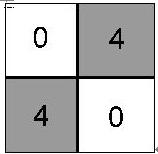
The first algorithm
Let ’s take a look at how to achieve the first level of grayscale. If the first method T0, T1, T2 is used, the pixels will display white at three times, and at T3, the grayscale will be displayed at 4 levels (because the TN panel pixels cannot be directly Display 1, 2, 3 grayscale), so the observer gets (0 + 0 + 0 + 4) / 4 = 1 grayscale, we can also see that it takes 4 cycles to get a color , This time is obviously a bit longer. 
If the second algorithm is used, three pixels in the square array composed of four pixels display white and one pixel displays 4-level grayscale, so that one-level grayscale color can also be approximated.
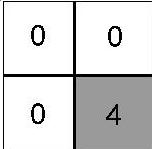
The second algorithm
We have to admit that the invention of the dithering technology has solved the problem of the TN panel's inherent color shortage to a certain extent, but this is not a perfect solution. The directly exposed problem is the visible pixel jitter and the inability to get 253, 254 and 255. The three gray levels, even if color dithering is applied, can display only three primary colors of 0 to 252 gray levels, so the final color display information is 253 × 253 × 253 = 16194277, which is about 16.2M colors.
Response time: I believe many consumers do not understand response time correctly? That ’s right, this is a new term brought to us by the era of liquid crystal displays, and an indicator that LCD manufacturers have focused on hype in the past year, but when you continue to look at this part, you will understand that the current manufacturers have to It is too easy to make a fuss about this indicator.
Response time This professional LCD indicator was first introduced by the International Organization for Standardization (ISO). The specification code is ISO13406-2. The original intention of the specification was to reflect the smoothness and clarity of the dynamic image of the LCD display. The specification defines the response time as follows: When a pixel's electricity changes from white to black, the electrode voltage changes from 0 to the maximum value, that is, under the maximum voltage excitation state, the liquid crystal molecules quickly switch to a new position. The time used for this process is This is called the rise time. When a pixel turns from black to white, the voltage applied to the pixel is cut off, and the liquid crystal molecules quickly return to the position before power on. This process is called the fall time. The entire response time process is the value obtained from the rise time plus the fall time.
In fact, the focus of the ISO specification on the definition of response time is still too simple. It only considers the time of the shortest pixel black, white and black extreme switching, and there is not much guidance value when measuring the most gray-scale switching that occurs in actual use. . We can think about the promotion tricks when manufacturers promoted 12ms LCD more than a year ago: "If the pixel conversion time is 12ms, the value of the screen that can be switched in one second is 1000/12 = 83, which is far greater. Due to the highest recognition rate of 60fps that humans can perceive, 12ms is the ultimate game LCD solution. "Of course, the performance of 12ms in gaming is believed to be clearer to the reader than the author. There are still obvious visible smears in FPS games until The 6ms and 4ms fast LCDs that appeared today have reached acceptable levels in the typical screen intense switching game CS. So what's the problem with ISO's definition of response time? Why is it so different from the actual one?
First, in the ISO specification, the entire pixel response definition only accounts for 80% of the entire pixel rise or fall process. According to the ISO definition, white refers to 10% grayscale, black refers to 90% grayscale, and the remaining 20% Time is ignored. The original intention of this definition of ISO is not difficult to understand, because for liquid crystal molecules, the two stages of power-on start and final stabilization are time-consuming, and the process of 20% grayscale conversion at both ends may exceed the time taken by the ISO response time definition itself Then, if these 20% are omitted, the indicators can be greatly beautified, but this is obviously unfair to consumers.

Response time test data
As shown in the test data of the response time of a liquid crystal display shown in the above figure, the rising edge time according to ISO defines 28.5-12 = 16.5 ms. But we observe the whole process of the conversion of the entire pixel from 0% gray to 100% gray. The actual time exceeds 40 ms, which is more than twice the time defined by ISO.
Of course, the defects defined by ISO are more than that. The most serious one is when the color change is ignored-that is, the time for different grayscale switching, which is also the most common display condition we use daily monitors. From the display principle of liquid crystal, when a pixel changes from a lighter gray to a darker gray, the voltage applied to the electrodes across the pixel also responds intensified. However, compared with the maximum excitation voltage defined by the ISO specification for black-and-white and black switching, the corresponding applied voltage during gray-scale switching is much lower, so in this case the speed of the liquid crystal molecule inversion response will also become slower. Similarly, when the color scale changes from a darker gray scale to a light gray scale, the process is reversed, but at this time, the electrode voltage corresponding to the light gray scale is also not zero, and the corresponding voltage difference excitation effect will also become worse, the falling edge The time will also become longer.
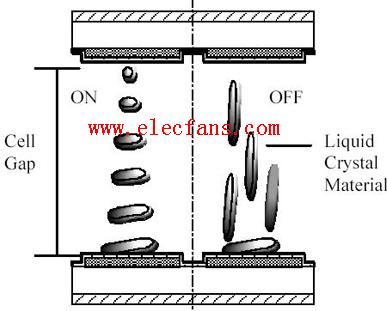
The display principle is precisely because the ISO specification does not force the manufacturer to consider the response time in the middle gray scale when providing the user response time parameter, so the operable space marked by the manufacturer is much larger. It is not difficult for users with earlier LCD experience to find that in the mainstream LCD a year ago, the display using the AUO AU 16 ms TN panel was faster than the LG-Philips 16ms with the same specifications or even Samsung ’s 12 ms. These three middle panels are faster than the 16 ms IPS panel, and what is puzzling is that they are all slower than Hydis' 20 msTN panel. This is precisely due to the lack of strict ISO response time specifications. The actual manufacturers The response time pointer given instead caused confusion for users.
Gray scale response is a pointer with reference value. As we said above, in the past, manufacturers have too much maneuverable space under the white and black response time indicators given by the ISO standard, so that the simple response time indicators are not too much. Multi-credible value, so from what point of view to get a more practical response time pointer, the answer is the "gray-scale response time" that some manufacturers began to promote in the second half of last year. 
Gray scale response time distribution diagram The above figure is the gray scale response time distribution diagram provided by NEC. As shown in the figure, the plane X and Y axes are the starting gray scale and the ending gray scale, and the Z axis represents the gray scale. Response time used during conversion. Let's take a look at the difference in response time between ISO definition, white to gray scale, and black to a gray scale under three different conditions.
ISO response time = (0-255) 18 + (255-0) 7 = 25 ms
Maximum response time from white to a gray level = 0–192–0 = (0 -192) 38 + (192-0) 5 = 43 ms (this is 78% slower than the index obtained under the ISO definition)
Maximum response time from black to a certain gray scale = 255–160–255 = (255-160) 55 + (160-255) 36 = 91 (this is 264% slower than the index obtained under ISO definition) 
Spatial distribution of response time of Philips 190S5 display
We can look at the picture above, which is the response time and space distribution diagram of the Philips 190S5 display obtained by our own test. Unlike the above picture, the bar value of this chart directly includes the rising and falling edges. time. We can see that the longest time occurs in the conversion process of two darker gray levels, and the process from pure white to pure black is among the fastest.
Through the above analysis, I believe that readers have a certain understanding of the concept of response time, and will also agree with the conclusion that if the response time really has practical reference value, then provide the necessary gray-scale response time parameters It makes sense, and at the same time, to make the response time factor really improve the performance of consumers' actual applications, then it is really meaningful to accelerate the speed of conversion between grayscale and grayscale, that is, the speed of color switching.
This year's most fashionable LCD technology "overdrive"
Obviously, for the LCD response time problem we discussed above, manufacturers also know that they cannot continue to promote "black and white and black response time", so how to increase the speed of LCD switching in gray scale is also exerted by various manufacturers in the second half of last year. The focus of the "GTG" gray scale response speed and "overdrive" rapid response technology has also begun to appear in large numbers in the mid-to-high-end LCD new products launched in the past six months, so we really need to know about all aspects of "overdrive" .
Speaking of "overdrive", we must mention the FFD technology developed by NEC for LCD TVs in the second half of 2001. It can be regarded as the predecessor of "overdrive" technology. In fact, the principle of this technology is quite simple. When we change from white (ie, the initial liquid crystal molecular state) of the TN screen to black (the liquid crystal molecules are in the direction of the voltage perpendicular to the light), the thin-mode transistor behind the liquid crystal pixel point is The excitation voltage is the largest, for example: the conversion process of liquid crystal molecules from white to black under 1V voltage excitation takes 20ms. NEC's FFD technology is considered as follows: why don't we double the excitation voltage to get a faster response time: for example, add 2V to get a response time of 10 ms. And from the research report released by NEC at that time, this technology is feasible. By increasing the excitation voltage during gray-scale conversion, the time spent in the gray-scale conversion process can be reduced.
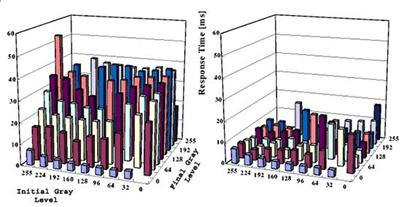
We can look at the graphs in the research report released by NEC at that time. The left side of the table is the response time and space distribution chart measured without FFD technology, and the right side is after FFD technology. Test results, we see, especially in the process of gray-scale conversion, the biggest improvement score is reduced from about 55ms to 6 ms. What we should pay attention to is that the left and right images have no change in the pure white-black-white response time. We can understand this because the excitation voltage applied by the electrode in the process of pure white to pure black is already the maximum. So no improvement is justified. Although NEC did not apply this technology to the display field (because the starting point of this technology is to improve the response speed of LCD TVs), but Overdrive technology, which has the same technical principle as FFD technology in the second half of last year, began to be used in mid-to-high-end LCD displays. It's popular.
In fact, FFD and overdrive basically changed their names, which is very common among different manufacturers. For example, BenQ uses the name "overdrive", and ViewSonic will call the same thing "ClearMoTIv." In fact, they are all the same thing, let's take a look at what substantial performance improvements "overdrive" can bring us. 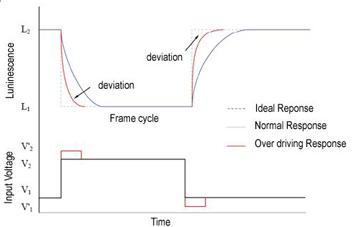
What substantial performance improvements can "overdrive" bring?
As shown in the figure above, the blue curve at the top shows the reaction process of the liquid crystal molecules under normal conditions after voltage is applied, and the corresponding voltage condition is represented by the black line below. We see that from the start of voltage application to the stabilization of liquid crystal molecules is not a static process, and the light blue dotted line represents the ideal response that the liquid crystal pursues. The triggering process of Overdrive, ClearMoTIv and general liquid crystal is in the input voltage stage. We can see that in order to achieve a faster reaction speed of liquid crystal molecules, a higher excitation voltage will be applied in the initial stage than in the normal state. When the molecular direction tends to the target direction, the excitation voltage returns to the target gray scale level.
Through the above analysis, all of us should clear Overdrive and similar technologies mainly to improve the gray-scale change of color. On the other hand, it also shows that the technology will not actually improve the traditional white-black-white response speed, because in such extreme conditions, the excitation voltage applied to the pixel has reached the maximum value. However, manufacturers are faced with such a problem. If defined according to the traditional ISO response time specification, even if Overdrive will greatly improve the speed of gray-scale conversion, they are not allowed to increase the corresponding time figure of the panel. This is why we have seen the new term "GTG response time" in the past year. At this time, a new corresponding time test method was born with the application of Overdrive technology. This method is not to test the time of "white and black" switching according to the ISO standard, but to grayscale switching (lighter grayscale-darker grayscale-lighter grayscale), the shortest one after the manufacturer measures all the corresponding time The value becomes the new "GTG response time". In other words, the previous 16ms ISO index became 12 ms G2G in a few weeks.
Overdrive is not a panacea. Although the Overdrive we have seen really accelerates the response speed of liquid crystal molecules during grayscale switching, we have to remind everyone here that this technology is not the panacea we imagined. Exaggeration and some problems of the technology itself are destined to be only a transition plan.
The first is the excessive publicity of some manufacturers. I will not mention the specific one here. The following is a comparison chart of its performance improvement after using Overdrive.
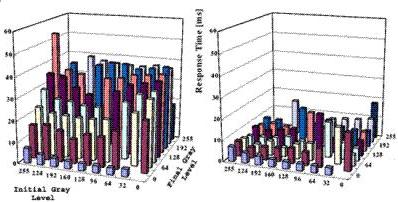
Comparison chart of performance improvement after using Overdrive From this chart, Overdrive is indeed very effective. Some gray-scale transition processes with a response time of up to 80ms are shortened to less than 20ms. But as long as we look closely, we will find that this picture is not realistic. We see that the typical "white-black-white" response time of the chart is also reduced to below 10ms, which is impossible. According to our analysis of Overdrive technology above, due to the "white-black-white" transition process has been The maximum excitation voltage is applied, so this process does not benefit from Overdrive. As a manufacturer, such publicity is somewhat irresponsible.
Furthermore, the author learned from the AUO working friends that in fact the TN 16 ms, 12 ms and 8 ms monitor panels we see are the same. The reason for the difference in response time is because of the rear drive Circuit and whether to use Overdrive technology. He also said that in fact, the current Overdrive has not yet processed all the grayscale conversions, but only a part of them, but he did not give a clear number, and finally the Overdrive processing response time data is given. It is actually the best part of the test.
Let's take a look at the response time and space distribution diagram given by Eizo (in fact, everyone knows that Eizo does not produce its own panel, this panel is provided by AU). 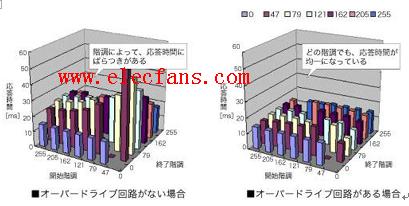
The response time and space distribution diagram can be seen from the above figure. The effect of overdrive is obviously easy to see, but the effect is often different for different color levels, and not all color level conversion processes need to be pressurized and speeded up. The most obvious in the chart is from White to any gray level is no different before and after using overdrive.
At the same time, manufacturers will inevitably leave consumers with a bad impression during the transition from ISO response time to gray-scale response time. Like the original ISO response time, it is directly linked to the elimination of residual image on the LCD screen, but overnight It seems that the time has become gray scale again to reflect this pointer. The previous ISO gray scale does not have any reference value. Then we can't help but wonder whether this gray scale response time is also a hype that the actual effect is greater than the publicity effect? It has actually been proven that if consumers really want to find a LCD that can be used in games, they still have to rely on their own eyes to receive the goods. To be sure, TN is ahead of VA and IPS panel products in response time indicators. If games play an important part in your computer applications, then you have to compromise on color and other image quality indicators. (The latter part will describe the color defects of the TN panel in detail). 
Game renderings
The benq FP91V monitor uses the fastest 4MS GTG TN panel currently. The picture above is the CS game scene we shot when we used a digital camera to open the shutter at 1/100 second. You can see that although the action is more intense, the afterimage of the screen has been basically Not aware, it can be said that such a product can already meet the gaming needs of most consumers.
Understanding the actual value of LCD brightness and contrast The concept of contrast has been passed down from the CRT era. This pointer refers to the ratio of the brightness of the brightest and darkest pixels in the image displayed on the screen. In other words, in order to obtain higher contrast, we hope that white is whiter and black is more pure. For example, if we measure the white brightness of a certain LCD screen as 250 cd / m², and the black brightness as 0.5 cd / m², then the contrast ratio of the display is 500: 1 through the formula black / white = contrast. It can be seen from the definition of this indicator that if manufacturers want to improve this indicator, there are undoubtedly two ways to improve black purity or increase white brightness. The former is obviously the pursuit of every manufacturer (because LCD black is a common problem), and the latter Easier to achieve.
Let ’s take a look at the first way to improve black purity. For manufacturers, this method is not impossible, but the relative technical effort is greater, improving the filter structure or improving the vertical light arrangement of liquid crystal molecules. To improve light leakage. Compared with this, it is much simpler for manufacturers to increase the brightness value of white, increase the number of lamps, switch to brighter lamps, and improve the efficiency of light guide plates. .
Let us take an example. At present, the technical level of backlight module production reaches 500 cd / m² white brightness value, while the black brightness value remains at the original 0.5cd / m² level, then we can get 500 / 0.5 = 1000: Higher contrast parameter of 1. But in fact, such a screen will only dizzy the bright people.
In fact, many friends who use the LCD minister will reflect that it seems to be more eye-consuming than the original CRT. In fact, they are caused by the use of the default high brightness. The brightness value recommended by experts for long reading work is It is around 110 cd / m², and the general brightness of traditional .CRT is 90 cd / m² (not to mention the highlight model, CRT highlight is not suitable for reading when it is turned on). For eye recognition, the current brightness of 250 cd / m² or higher provided by LCD is too bright. It is because the excessively high brightness causes the user ’s eyes to accelerate fatigue, which feels more uncomfortable than CRT. If you face In this case, I suggest that you adjust the brightness of the LCD screen to an appropriate position.
So why do manufacturers provide LCDs with such high brightness that they are not suitable for use? One of them can certainly improve the user's perception of multimedia such as video; the second is to use the increase in brightness to beautify the contrast index. This is also a hole in the ISO's contrast specification, because the specification does not stipulate that all products must be at the same white brightness value, such as 110 cd / m², to measure the black brightness value at this time. In the case where it is difficult to improve the purity of the liquid crystal black, manufacturers will naturally use the brightness that is easier to improve.

LCD is not as bright as possible

As far as the panel technology is concerned, the current contrast ratio of IPS and VA panels is generally better than that of normally bright panels such as TN, and the contrast ratio is not higher than 700: 1. The main advantage is that the black performance is better than the TN panel. Of course, I do n’t need to elaborate on the benefits of high contrast. Pure black can make the picture more prominent and rich in layers. At the same time, we can see more details when viewing pictures and hard drives. At the same time, the higher contrast for the player can not only improve the experience of the game screen, but also in the game of CS, it is easier to observe the enemy hiding in the dark. Of course, it is better to choose good quality for pure pursuit of game performance Large screen CRT.
Xinxiang Mina Import & Export Co., Ltd. , https://www.mina-motor.cn